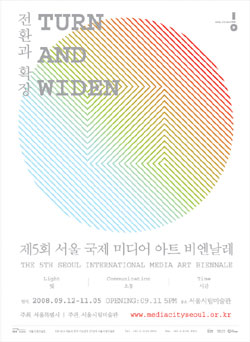 Long overdue…. A follow-up on media_city Seoul, a media art biennale hosted until November 5, 2008 at the Seoul Museum of Art.
Long overdue…. A follow-up on media_city Seoul, a media art biennale hosted until November 5, 2008 at the Seoul Museum of Art.
The events aims to reflect on the place that media art has taken into contemporary art. Each in their own way, the works selected for the exhibitions bring a fragment of answer to fundamental questions such as: What is media art? What is different from the conventional art? What changes have been made by that in the field of art? and what influences could come from now?
In order to ensure a broader and more informed coverage of these issues, Park Il-ho, exhibition director, professor at Ewha Womans University and main curator of media_city Seoul surrounded himself with four international curators: Maarten Bertheux from the Stedelijk Museum, independent art curator and critic Raul Zamudio, curator of Tokyo’s National Museum of Modern Art Tohru Matsumoto and art historian and curator Andreas Broeckmann.
I had the opportunity to attend a talk in which Broeckmann shared with the audience his point of view on some of the questions raised by the media art biennale: What can be defined as media art today?
Most of you probably know Andreas Broeckmann as the artistic director of the transmediale festival (2000-2007) and the co-director of the media arts lab TESLA in Berlin (2005-2007). The curator and art historian recently co-chaired the re:place 2007 interdisciplinary science and art history conference and is currently working on the next edition of ISEA which will take place in the Ruhr area (Dortmund, Essen, Duisburg, a. o.) in August 2010.
Below are my (fairly rough) notes from the talk.
10 years ago it was easier to define what media art was, any artist using computer, video or the net in his creative practice was qualified as a media artist. In the Netherlands they call it ‘art with a plug’. The idea of what constitutes media art has evolved over the past few years and it no longer makes sense to focus solely on the technical media in use.
Questions such as What does it mean to speak of media art today? or What is the territory of media art today? have given rise to many ongoing discussions and are even the core subject of a couple of exhibitions (such as media_city Seoul). One of these exhibitions closed yesterday at the Stedelijk Museum in Amsterdam. Deep Screen – Art in Digital Culture. Proposal for Municipal Art Acquisitions 2008 was organized with the objective of getting a sample of contemporary media artists living in The Netherlands. The Stedelijk plans to select a few artworks from the sample and buy them for its permanent collection. The questions they museum asked right from the start was ‘How can we bring this recent art, with its own aesthetics and thematics into the collection?’
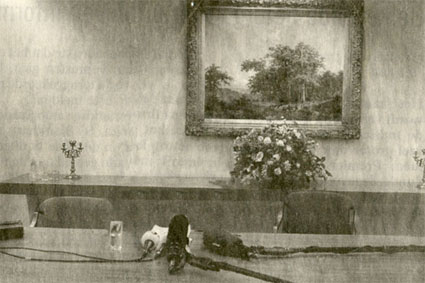
Persijn Broersen and Margit Lukács‘ Hinterland #2 series (exhibited at the Stedelijk)
Broeckmann’s conviction is that in fact not much of it is really new for the Stedelijk. After all, they have been buying such artworks for 40 years now: Fluxus works, videos by Abramovic, Bill Viola, etc. Media art shouldn’t be reduced to technology, some media art pieces are just good examples of conceptual art and have other strong connections with modern and post-modern art.
We are now living a historical time when digital technology is used everywhere everyday. We don’t have to think about it anymore. It just became so natural. Only a tiny minority of people had a mobile phone 10 years ago. Today we all have one. Being connected is easy and that’s the way we expect it to be. Yet people keep seeing media art as something different, a genre which puts a heavy emphasis on technology and when we speak about art, it mostly refers to art creation that uses analog media.
In the past, when technologies were news, artists were engaging with it in a free and often very explorative way. Now that they have mastered the technology the focus is mostly on making good art. Of course some artists are still developing complicated art pieces but we are seeing much more work using easy, hand-on technology.
An important question to raise is: What happens to art when it has reached the phase beyond digital technology novelty? We used to be fascinated by technology and now it is so much part of our life that we don’t have to think about it anymore.
Many people have the feeling that we still describe something when we say ‘media art’. Which role does media art has in contemporary art? Are there particular themes, ideas or fields that media art references?
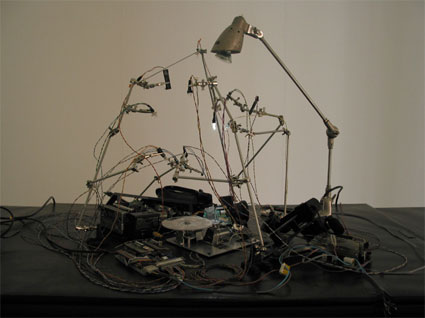
One of the works shown at media_city Seoul illustrates a possible answers. At first look, Julien Maire‘s Exploding Camera is a heap of electronics on a table. The bits and pieces belong to a video camera which, although it was disassembled, is still perfectly functioning. The lens has been taken out. Instead, external light coupled with LEDs and laser produce video images by direct illumination of the camera’s CCD (light sensor). A transparent disc containing photographic positives is placed between the lights and the CCD. The pictures are projected onto the CCD when a light is turned on. Because of the different position of the lights, movement in the same picture can be created. Large lights and the laser create explosions (they trigger a sound that overlays the backing soundtrack).
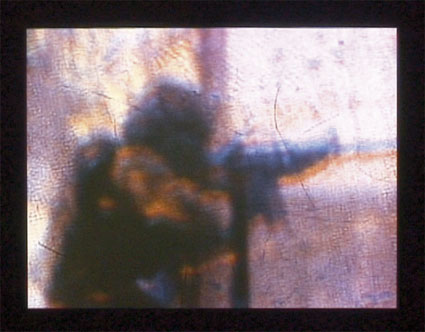
Exploding Camera Screenshots
The installation was inspired by the murder, two days before the 9/11, of the most credible opponent to the Taliban: Commander Massoud.
Two al-Qaida suicide bombers posing as journalists killed him with an exploding camera at his camp in Afghanistan’s remote Panjshir Valley.
Although the murder is connected with 9/11, it has been almost completely forgotten because of the magnitude of the events a few days later.
The artist wrote: For me, it is as if the destroyed camera used in the attack against Massoud had continued to work and has been filming a war film for the last 6 years.
All of this, as well as the death of the almost mythic figure of Massoud, has lead me to develop the piece ‘the exploding camera’: a kind of destroyed medium able to produce live an experimental historical film reinterpreting the events of the war.
Just like Persijn Broersen and Margit Lukács‘ Hinterland #2 series (exhibited at the Stedelijk but not in Seoul), the work deconstructs the technology of audiovisual media in order to better reflect on the way that it works. This theme is often explored in media art and could therefore constitute an element that contribute to its definition.
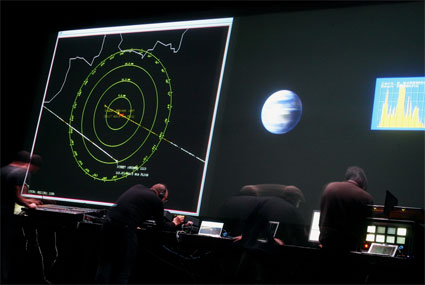
Marko Peljhan, Speckr, Linz
An other relevant figure to consider is Marko Peljhan, an artist interested in social and political context of technology. He develops works in the Russian constructivist tradition of the 1920. His art projects deal with with technology and offer the public the opportunity to engage with them and talk about technology, scientific research, military developments, etc. The aesthetics of his work is directly inspired by the aesthetics of science and technology while exposing its dark side, the esoteric and sometimes irrational aspects of modern science.
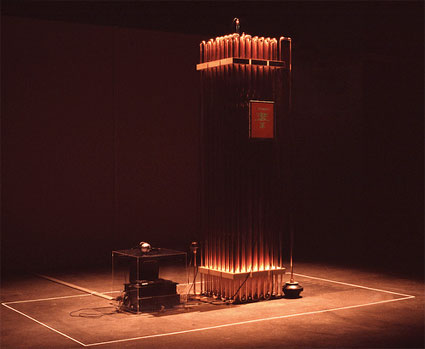
Hello World by Yunchul Kim
Hello, World!, offers an interesting dialog with mediality by showing the process of the translation from the digital to the analog through copper pipes. The installation, developed by Yunchul Kim, uses acoustic signals to store data. A codified auditory signal (feedback) circulates in a closed system consisting of a computer, a loudspeaker, 246 meters of copper tubing and a microphone. Due to the acoustic delay in the tubing system, it’s possible to save data, whereby the rule is: the longer the copper tubing, the longer the time delay and the greater the memory capacity.
Where is the medium in this work? Is it the computer with the hardware which carries the data file? Or is it the software? The electrical signal?

Driessens & Verstappen, Breed
Erwin Driessens & Maria Verstappen‘s Breed (also included in the Stedelijk exhibition) is a fascinating take on the theme of the transition from digital to analog. A computer program uses artificial evolution to grow very detailed bronze sculptures that represent virtual mathematical models. The purpose of each growth is to generate by cell division from a single cell a detailed form that can be materialised. On the basis of selection and mutation a code is gradually developed that best fulfills this “fitness” criterion and thus yields a workable form. The virtual designs become tangible artefacts through 3D printing techniques.

Driessens & Verstappen, Breed
The whole creation process is left in the ‘hands’ of the computer, there is no direct artistic decision. The final result is presented in a very traditional way: the print-out structures are cast in bronze and presented in a glass case.
Breed reflects on the relationship between virtuality and materiality but also the relationship human and machine creativity. Belonging both to the software art genre and the sculpture genre, Breed pushes the boundaries of mediality.
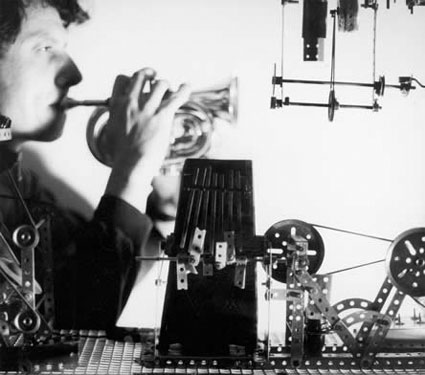
Pierre Bastien
The work of Pierre Bastien which engages mostly with mechanical age looks at the degree zero of media. He uses very basic (wind, voice, fans, etc.) media for human expression in a ‘post-machinic age’ scenario. It doesn’t make much sense to talk about new media art in this context but his work is an artistic expression that uses the most ancient media possible. On the other hand, it can be regarded as media art because of the way it reflects on the mediality of its own materiality (and vice-versa?.)
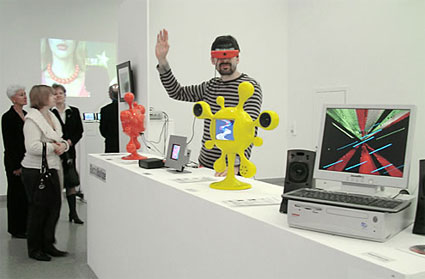
Electroboutique
Ironic wink from Alexei Shulgin and Aristarkh Chernyshev with their latest artistico-commercial adventure: Electroboutique, a conceptual project that playfully but intelligently reflects on the status of media art as another product of consumer culture. The Russian artists are exhibiting at media_city Seoul Super-i, a pair of goggles that allow visitors to reverse the virtual/real duality by transforming the “real” world around us into a pixelated one in real time.
Today, many electrical and digital technologies are available to artists, they are free to choose which one best fits their work. That didn’t use to be the case. There was a time when these technologies were expensive and not available to the hoi polloi. Nowadays, these technologies have been ‘liberated’. In the past, computers would limit what an artist could do, they were ‘imprisoned’. Today, an artist can decide freely whether it is software or wood that best correspond to their project. This also constitutes a liberation from the idea that the essence of media art is technology.
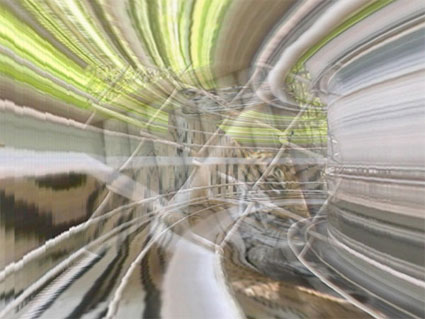
The Cage, by Tania Ruiz Gutiérrez, tries to re-create the experience of being incarcerated. The projection shows an image of a tiger kept prisoner in a zoo. The image is always the same, yet the tiger moves around his cage. The artist explains that the movement is in fact determined by the relative sizes of tiger and cage, such that his movements are optimized to the only possible path given the tight space available. Given that both the duration and the distance are repeated, one can imagine that in the tiger’s brain there exists a double incarceration, both spatial and temporal. Moreover, the tiger’s path traces over and over the sign of infinity. I would like to make visible the passing of a suspended time and give this installation both a reflexive and hypnotic character.
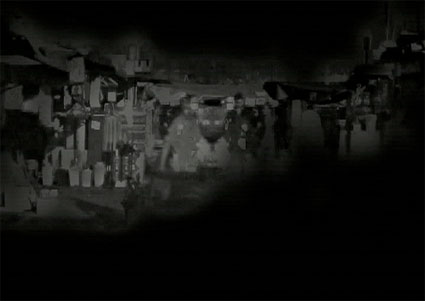
Pneuma Monoxyd, by Thomas Köner, is a visual metaphor of how time and memory intersect into our mind. The video installation merges in a dark blur surveillance images of a German shopping street and a Balkan marketplace.
These last works show how media art offer us new possibilities to look at the world in a different way.

Mark Hansen’s 2 channel video Other People’s Feelings Are Also My Own No.3 shows the artist in a similar outfit and facial expression as those of the man, woman or child in the picture next to his. The work explores notions of ego, subjectivity and identity but it also looks into the mediality of the human face and how much it can be used as a screen.

Herwig Weiser‘s sound sculpture Death Before Disko is a self-absorbed machine, it is a medium that could be qualified as ‘autistic’. It appears to be busy with itself and communicates as little as possible to the outside. ‘Death Before Disko’ uses an online data stream from space observation and translates it into sound and light events. With the proliferation of digital technologies, users have become more and more distant from the physical hardware of their laptop or hi-fi units. ‘Death Before Disko’ aims to return to the foundations of the hardware, and shows how our relationship towards technology is more often emotional than rational.
Broeckmann’s view is that it is getting less and less important to have specific media biennales and festivals. If a ‘media art’ piece is a good art piece it will survive as contemporary art.
Further reading: Deep Screen – Art in Digital Culture. An Introduction by Andreas Broeckmann.
![]()
































